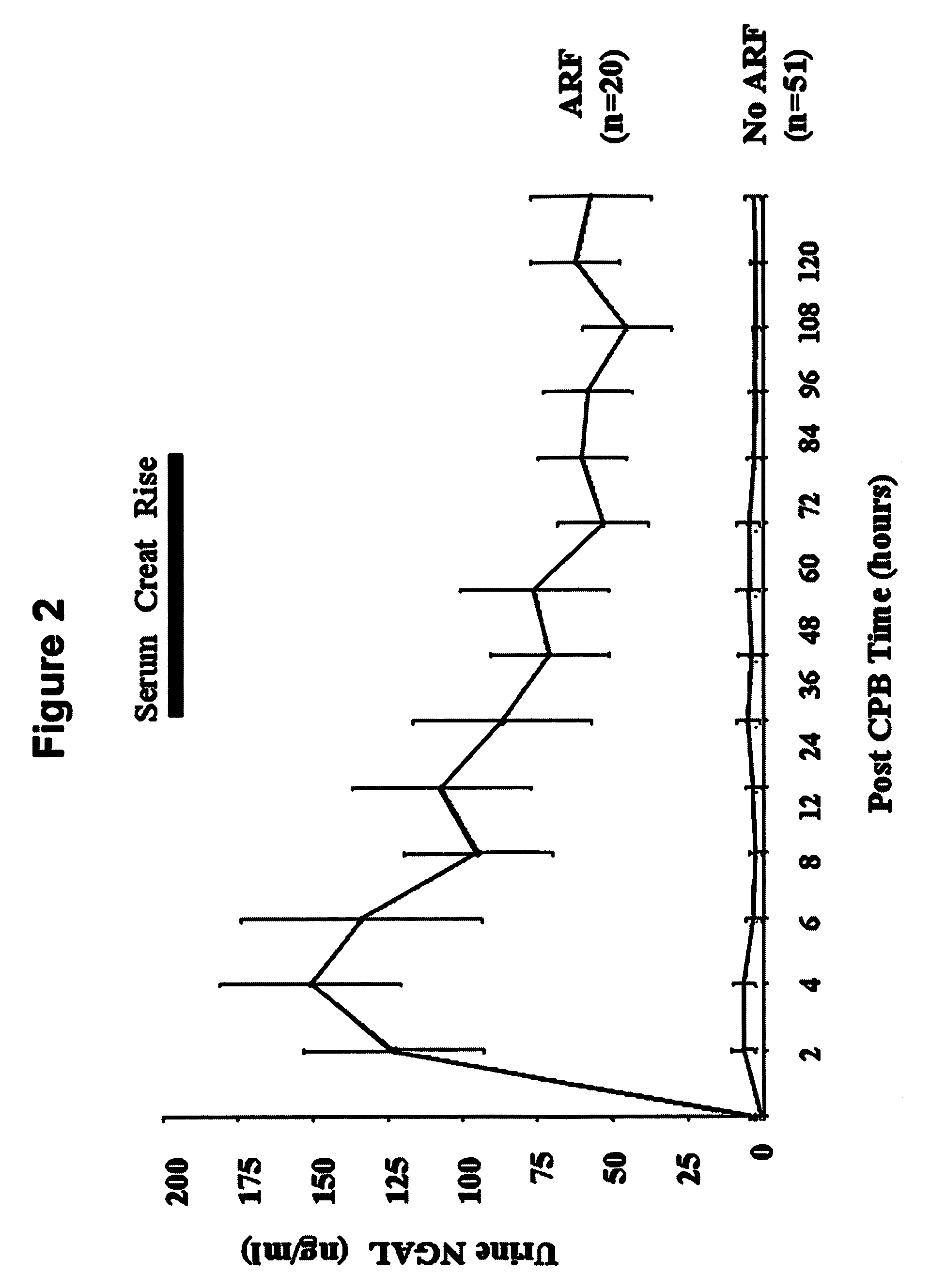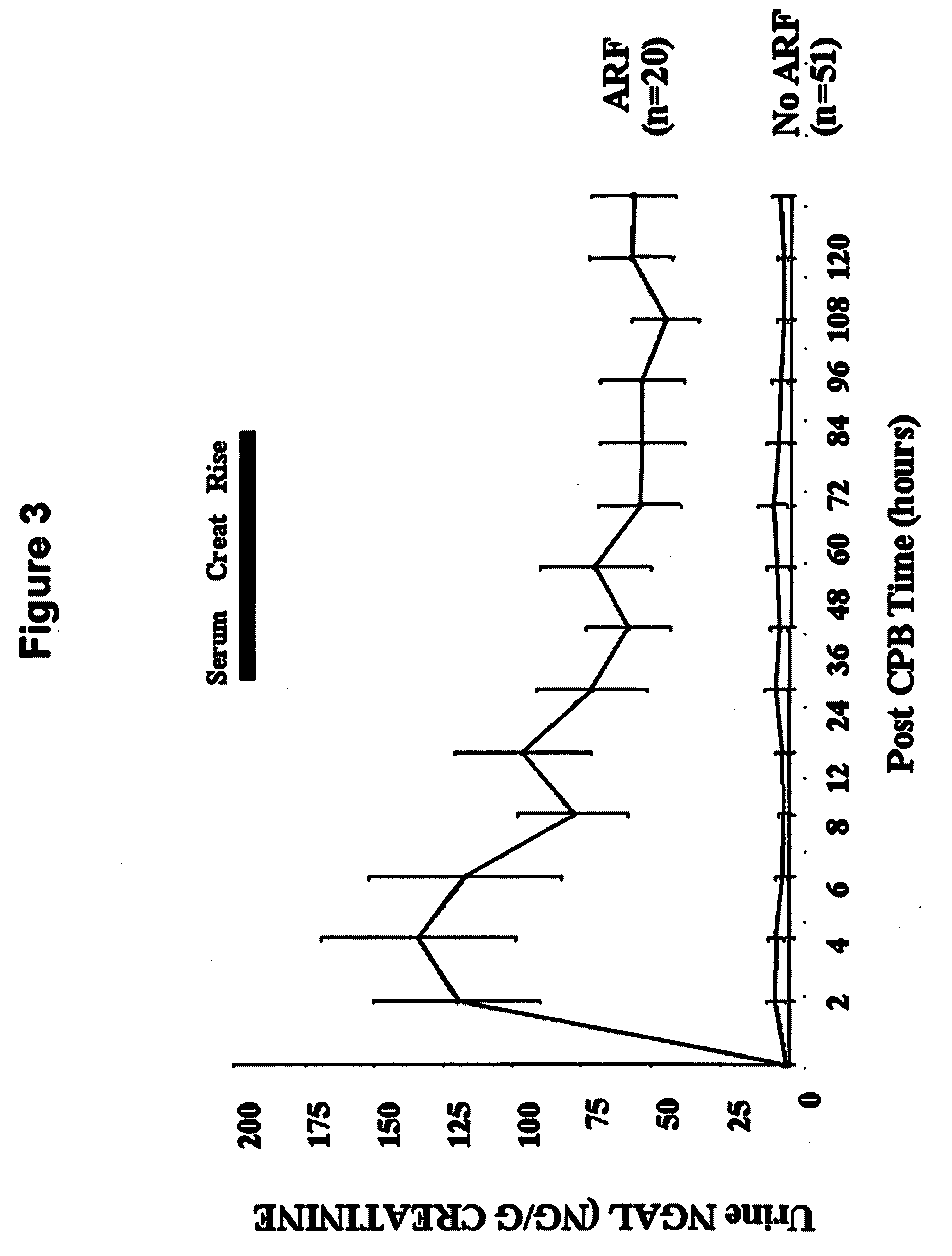Method for the early detection of renal injury
a renal injury and early detection technology, applied in the field of early detection of renal injury, can solve the problems of delayed initiation, and persistent high mortality and morbidity
- Summary
- Abstract
- Description
- Claims
- Application Information
AI Technical Summary
Problems solved by technology
Method used
Image
Examples
example 1
[0067] Western Analysis For NGAL Expression And Quantitation: Equal aliquots (30 μl) of each urine sample were boiled for 10 min in denaturing buffer and subjected to standard Western Blot analysis with an affinity purified goat polyclonal antibody raised against human NGAL (F-19, Santa Cruz Biotechnology). Simultaneous blots were prepared under identical conditions of transfer and exposure with known quantities of recombinant human NGAL, as standards for quantitation of urine NGAL as previously described by Mishra et al. in Am J Nephrol 2004;24:307-315. The laboratory investigators were blinded to the sample sources and clinical outcomes until the end of the study.
[0068] Urine NGAL Measurements—Western Analysis: NGAL was virtually undetectable in the urine of all patients prior to surgery, and in healthy volunteers (n=10). FIG. 1 shows a Western Blot typical of that for a patient undergoing CPB. NGAL is not detected at 0 hours, or before CPB, but rapidly appears in the urine by 2 ...
example 2
[0070] In patients who never developed acute renal injury, there was a small but statistically significant increase in urinary NGAL at 2 hours or the first available sample post CPB (4.9±1.5 ng / ml versus 0.9±0.3 ng / ml at baseline, p<0.05) and 4 hours post CPB (4.9±1.2 ng / ml, p<0.05 ver baseline). In marked contrast, patients who subsequently developed acute renal injury displayed a dramatic increase in urinary NGAL at all time points examined, as shown in FIG. 2. The pattern of urinary NGAL excretion was characterized by a peak very early after the precipitating event (2-6 hours following CPB), followed by a lesser but sustained increase over the entire duration of the study. This overall pattern remained unchanged when urinary NGAL concentration was normalized for urinary creatinine excretion (FIG. 3).
Example 4
[0071] Urine NGAL levels were consistently low in healthy volunteers (2.2±0.5 ng / ml, n=10) and at baseline in all subjects (1.6±0.3 ng / ml, n=71). In patients who never deve...
example 4
[0072] Serum NGAL Measurements—ELISA: Serum NGAL is a novel early biomarker of ischemic renal injury, similar to troponins in myocardial ischemia, and detection of serum NGAL is an example of the invention. Serum NGAL levels were consistently low in normal healthy volunteers (2.5±0.8, n=6) and all study subjects prior to surgery (3.2±0.5 ng / ml, n=71). Patients who never developed acute renal injury showed a small but statistically significant increase in serum NGAL at 2 hours or the first available sample post CPB (7.0±1.1 ng / ml, p<0.05 versus baseline) and 12 hours post CPB (5.2±0.8 ng / ml, p<0.05 versus baseline). Patients who subsequently developed acute renal injury displayed a striking increase in serum NGAL at all time points examined, as shown in FIG. 7. Similar to urine NGAL, the serum NGAL peaked very early after CPB, followed by a lesser but sustained increase over the entire duration of the study. Serum NGAL levels were 61±10 ng / ml at 2 hours, 54.7±7.9 ng / ml at 12 hours, a...
PUM
 Login to View More
Login to View More Abstract
Description
Claims
Application Information
 Login to View More
Login to View More - R&D
- Intellectual Property
- Life Sciences
- Materials
- Tech Scout
- Unparalleled Data Quality
- Higher Quality Content
- 60% Fewer Hallucinations
Browse by: Latest US Patents, China's latest patents, Technical Efficacy Thesaurus, Application Domain, Technology Topic, Popular Technical Reports.
© 2025 PatSnap. All rights reserved.Legal|Privacy policy|Modern Slavery Act Transparency Statement|Sitemap|About US| Contact US: help@patsnap.com



